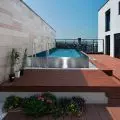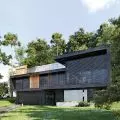Heretic of the thieves of Lodz, German pig, scoundrel, bandit, criminal, leech, vile dog, potato man - the young man reads the letter aloud. Having finished, he crumples the paper in his hand and throws it into the fire of the ornate fireplace. The space of the room, which is impressive in size and decorations, is filled with the loud retching of the other man. This one, who is older, although he does not rise from his wooden chair on wheels, spreads a frightening aura around him - he is violent, shouts in a low voice, using a strange mixture of Polish and German. He finds satisfaction in insulting and beating his servant, and amuses himself by reading letters containing either insults against him or pleas for help.
Herman Bucholc is the protagonist of "Promised Land" modeled on the Lodz industrialist Karol Wilhelm Scheibler. Unlike the character created by Wladyslaw Reymont, and after him by Andrzej Wajda in the film adaptation, Karol Scheibler is remembered as a brilliant businessman, creator of a powerful enterprise, builder not only of industrial plants, but also of houses for their employees and schools for their children, founder of public temples, father of seven children, thewhose eldest daughter, together with her husband, participated in the creation of the first children's hospital in Lodz.



Karol Scheibler's spinning mill, archival photo
photo: Bronislaw Wilkoszewski, source: Museum of the City of Lodz | Wikimedia Commons
Karol Scheibler's factory
The gentleman looking out from the archival photographs is dressed in a white shirt with a stand-up collar, a bow tie and a dark double-breasted jacket. His powerful nose and narrow, smileless mouth are flanked by lush sideburns, and he has thin, slicked-back hair on the top of his round head. A native of the Rhineland, Karol Scheibler gained experience in the textile industry in western Europe in the first half of the 19th century before settling permanently in Lodz, the rapidly growing industrial center of the Kingdom of Poland. In a few decades Scheibler created a huge enterprise from scratch, which, despite the damage accompanying two world wars and numerous transformations - including nationalization - survived until the early 21st century. The industrial plants with accompanying infrastructure, office, residential and social facilities located on several hundred hectares of the city's area still play a huge role in its spatial structure.
Today, the land and facilities that the city inherited from Scheibler's enterprise are looking for a new use. Only the complexes of workers' houses have retained their residential function (a number of buildings at the former Water Market are impatiently awaiting renovation, publicly financed renovation work has been going on for several years on the estate of houses in Księży Młyn, and targeted partial gentrification is being carried out). Representative residences of the owners have become cultural facilities (the Museum of Cinematography, a branch of the Lodz Museum of Art), public buildings have been settled by universities (the Academy of Fine Arts in a former school and a private School of Art and Design in a former orphanage for children from working-class families). In contrast, some industrial buildings are awaiting development or are gradually deter iorating (such as the so-called New Weaving Mill on Kilińskiego Street, today a ruin hiding under a faded banner reminding us of John Paul II's visit to the site). Others of the post-factory buildings have been adapted for new office or residential functions (the adaptations and conversions have not always been accompanied by successes and reasons to be proud).
Fusion
Part of the post-factory complex located in the quarter of Kilińskiego, Tymienieckiego, Piotrkowska and Milionowa streets is the site of the "Fusion" investment. The investor is Echo Investment, a company with a portfolio including "Browary Warszawskie". Medusa Group is responsible for the site development concept and designs of new buildings in the southern part of the investment. Meanwhile, designs for the redevelopment of existing post-factory buildings in the northern part of the complex are being developed by MOFO Architekci studio.
New residential and office buildings are being constructed on an area of just under eight hectares. Some of the existing post-factory buildings will undergo renovation and conversion to office, retail and service functions, and a cubic parking lot and hotel are also to be built. The simple, rhythmic facades of the new buildings are finished with graphite clinker tiles and gold-colored sheet metal elements.



Visualization of the "Fusion" investment
© investor materials
The entire development forms a compact frontage for a regular grid of streets and passages, which, together with a public square, allow us to anticipate that in the future this complex system of public spaces will connect the investment with the surrounding city, without creating a closed enclave.
The heart of the complex will invariably remain for a hundred and ten years the building of the former power plant, erected in 1910, according to a design by engineer Alfred Frisch, in reinforced concrete construction. Referring to the surrounding buildings, its facades are partially faced with red clinker bricks, but that's where the similarities with other factory buildings end. The masses of the two halls that make up the building have three-bay gable elevations in a basilical arrangement, and the soft arches of the windows and stained glass windows filling them, combined with a rather free interpretation of the arcade cornice, bring to mind associations with Art Nouveau, unusual for industrial buildings in Lodz. The renovation of the building's exterior has now been completed, and the investor declares that the interior will be used for cultural and entertainment purposes in the future.



power plant building during façade renovation
© investor materials
everyone can build their own power plant!
With the support of Echo Investment, Michal Duda, a resident of Łódź, designed and built a model of Scheibler's power plant using LEGO bricks. The set, consisting of 1,910 elements, is gathering votes on the LEGO IDEAS website in favor of being put into production and sold as an official set signed by the Danish toy manufacturer. You can cast your vote for the first Polish LEGO set on the LEGO IDEAS website - Art Nouveau Scheibler's Powerhouse
powerhouse model
© fuzjalodz
coincidence
"Fuzja" is the meeting point of factors without which, in Polish and Lodz conditions, it is difficult to create a high-quality space that can become an integral part of the city. The current Local Spatial Development Plan gives the right direction for the formation of public spaces, appropriately balances the protection of cultural values and investment opportunities. The inclusion of the entire area and some of the buildings under conservation protection allows us to hope that the spirit of the place will not be chased away by the sound of bulldozer engines. And finally, an investor who consciously takes on the challenge, while inviting a suitably sensitive designer.


 .
.
Visualization of the investment "Fusion"
© investor materials
river
Near the place where the company overhauling the district heating network lost several meters of thick plastic pipes, a small silver can on a chicken foot emerges from the thick grass. The foot grows out of a metal grating placed on the ground. From under the grating, the sound of flowing water can be clearly heard. A faded inscription on the can informs that the Lamus River is flowing briskly under the reader's feet, and a metal and plastic element attached next to the inscription that resembles a bicycle pedal set in motion will power the lighting placed under the grating, proving that the sound of flowing water is by no means a hallucination.
Lamus is one of twenty named rivers flowing within the administrative boundaries of Lodz. Those that had the misfortune to flow through today's city center were channelized and hidden underground at the turn of the 20th century. At the threshold of "Fusion," a strip of no-man's land (ownership structure - "another type of ownership") runs between the new residential buildings and Milionowa Street, which timidly communicates to passersby that water also flows under its surface and is perhaps waiting for a daredevil to let it rise to the surface.























